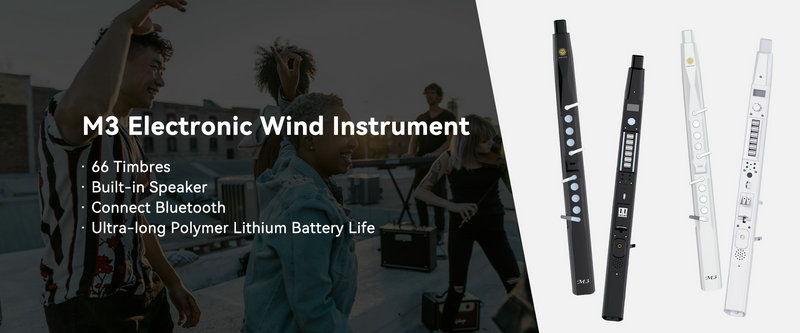What Can MIDI Do with Electric Wind Instruments Besides Sound?
Electric wind instruments (EWIs) have become increasingly popular in the music world, offering musicians a unique combination of traditional wind instrument playing techniques and advanced digital technology. One of the key technologies that can be integrated with EWIs is MIDI (Musical Instrument Digital Interface). While MIDI is often associated with sound generation and control, it can offer much more when used with electric wind instruments. In this article, we will explore what MIDI can do with electric wind instruments besides sound.
I. Introduction to Electric Wind Instruments and MIDI
Electric wind instruments are musical instruments that use electronic sensors and digital processing to produce sound. They can mimic the sound of traditional wind instruments such as saxophones, trumpets, and flutes, as well as a wide range of other sounds. MIDI is a protocol that allows different musical instruments and devices to communicate with each other. It enables the transmission of musical data such as notes, velocities, and control signals.
II. MIDI Control of Effects and Parameters
One of the main ways that MIDI can be used with electric wind instruments besides sound is for controlling effects and parameters. Many EWIs come equipped with built-in effects such as reverb, delay, and distortion. MIDI can be used to control these effects in real time, allowing musicians to adjust the settings on the fly during a performance. For example, a musician could use a MIDI foot controller to turn on and off a reverb effect or adjust the amount of delay.
In addition to controlling built-in effects, MIDI can also be used to control external effects processors. By connecting an EWI to an external effects unit via MIDI, musicians can access a wider range of effects and have more control over their sound. MIDI can be used to send control signals to the effects unit, allowing for parameters such as filter cutoff, resonance, and modulation to be adjusted in real time.
MIDI can also be used to control other parameters on an EWI, such as volume, pitch bend, and modulation. By assigning MIDI controllers to these parameters, musicians can have more expressive control over their playing. For example, a musician could use a MIDI expression pedal to control the volume of their EWI, or a MIDI knob to adjust the pitch bend range.
III. MIDI Sequencing and Recording
Another way that MIDI can be used with electric wind instruments is for sequencing and recording. MIDI sequencers are software programs or hardware devices that allow musicians to record and edit MIDI data. By connecting an EWI to a MIDI sequencer, musicians can record their performances and then edit the MIDI data to fine-tune the timing, pitch, and other aspects of the performance.
MIDI sequencing can be especially useful for composers and arrangers who want to create complex musical arrangements. By using a MIDI sequencer, they can layer multiple tracks of EWI performances, along with other instruments and sounds, to create a rich and textured musical composition. MIDI sequencing also allows for easy editing and rearrangement of the music, making it a powerful tool for creative experimentation.
In addition to sequencing, MIDI can also be used for recording live performances. Many digital audio workstations (DAWs) support MIDI recording, allowing musicians to capture their EWI performances along with other instruments and vocals. MIDI recording can be useful for capturing ideas quickly or for creating a reference recording that can be used for further refinement later.
IV. MIDI Integration with Other Musical Instruments and Devices
MIDI can also be used to integrate electric wind instruments with other musical instruments and devices. For example, an EWI can be connected to a synthesizer via MIDI, allowing the musician to trigger sounds on the synthesizer using the EWI. This can be a powerful way to expand the sonic possibilities of an EWI, as synthesizers offer a wide range of sounds and effects that can be controlled via MIDI.
MIDI can also be used to connect EWIs to drum machines, sequencers, and other rhythm-based devices. By synchronizing the EWI to these devices via MIDI, musicians can create complex rhythmic patterns and grooves that interact with their playing. This can be especially useful for electronic music genres such as techno, house, and trance.
In addition to connecting to other musical instruments, MIDI can also be used to control lighting and visual effects. By using MIDI controllers to send signals to lighting consoles or visual effect software, musicians can create a synchronized multimedia experience that enhances their performances.
V. MIDI for Education and Practice
MIDI can also be a valuable tool for education and practice with electric wind instruments. Many EWI manufacturers offer software or apps that use MIDI to provide interactive learning experiences. These programs can display musical notation, play back examples, and provide feedback on a student's playing. MIDI can also be used to record and analyze a student's performances, allowing for targeted practice and improvement.
For professional musicians, MIDI can be used for practice and rehearsal. By recording their performances and then playing them back along with a metronome or other reference track, musicians can identify areas for improvement and refine their playing. MIDI can also be used to create practice loops or backing tracks that can be used for solo practice or rehearsal with a band.
VI. Conclusion
In conclusion, MIDI can do much more with electric wind instruments than just produce sound. From controlling effects and parameters to sequencing and recording, integrating with other musical instruments and devices, and providing educational and practice tools, MIDI offers a wide range of possibilities for musicians who play electric wind instruments. By exploring these possibilities and incorporating MIDI into their playing and creative processes, musicians can expand their sonic palette, enhance their performances, and unlock new levels of creativity.
SUNRISE MELODY M3 Electronic Wind Instrument - The best-selling Electronic Wind Instrument
. 66 Timbres
. Built-in Speaker
. Connect Bluetooth
. Ultra-long Polymer Lithium Battery Life



